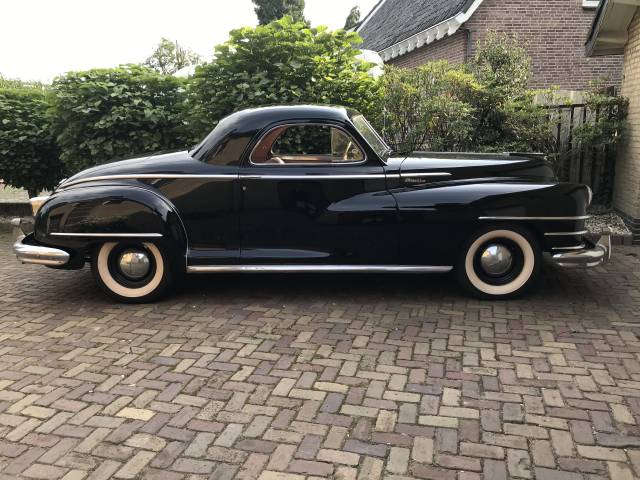Chrysler Royal classic cars for sale
The Chrysler Royal stands as a benchmark in pre- and post-war American automotive engineering, offering a wide array of body styles and robust inline engines. With a production run interrupted by significant design upgrades and technology advances, the Royal is an attractive option for enthusiasts seeking a solid representative of Chrysler’s historic model line.
Suchergebnisse

1948 | Chrysler Royal
Chrysler Royal 2 door Business coupe 1948
History of the Chrysler Royal
The Chrysler Royal first appeared in 1933 as a full-size car and remained in production—with interruptions—until 1950. Its initial release introduced the Series CT, featuring a choice of two wheelbases and a variety of body types, including coupé, convertible, and sedan configurations. The original version was powered by a side-valve straight-eight engine with a displacement of 4,485 cm³ and an output close to 90 hp, with a higher-compression upgrade achieving nearly 100 hp. Production paused after 1934 and resumed with the Series C16 in 1937, marking the next generation of the Royal.
Model History
After its debut in 1933, the Royal was succeeded by the Series C16 in 1937. That year alone, Chrysler produced around 86,000 Royal units, now powered by a 3,737 cm³ six-cylinder engine delivering roughly 94 hp, with a more potent 101 hp variant available. The 1939 Royal featured a comprehensive redesign, showcasing innovations such as an alligator-style bonnet and integrated fender headlights. Body options ranged from coupés to two- and four-door sedans, as well as the luxury Royal Windsor variant. The final iteration appeared between 1949 and 1950 (C45S/C48S), offering up to 117 hp and, for the first time, a station wagon body. The Royal’s production concluded in 1950.
Highlights of the Chrysler Royal
The Chrysler Royal distinguished itself with engineering versatility—spanning straight-eight and six-cylinder engines, and a broad palette of body configurations. Noteworthy are the 1939 model’s V-shaped split windscreen and fender-integrated lamps, which reflected the design trends of the era. By 1950, the two-piece grille and introduction of a station wagon body format further amplified its appeal.
Technical Data
Special Editions and Collectible Models
Certain Royal models, such as the Royal Windsor or the station wagon introduced in 1949, stand out due to their enhanced specifications and rarity, especially as the wagon variant marked a first for the model series. Limited production runs in specific years also make early and late Royal models especially sought-after for their unique design and engine configurations.
Weak Spots and Common Issues
No specific information about recurring issues or typical weak spots for the Chrysler Royal series is available. As with many vehicles of this vintage, potential buyers should closely inspect for age-related wear, rust on bodywork and frame, and the condition of original engine components.
Engine and Performance, Transmission and Handling
The pre-war Royal relied on robust straight-eight and, later, six-cylinder engines, prioritising smooth running and reliability over high performance figures. The availability of both standard and higher-compression engine versions allowed buyers to choose between comfort and modestly improved performance. The introduction of upgraded suspensions and longer wheelbase options in later models enhanced ride quality and passenger comfort, while design updates brought not only visual but also aerodynamic improvements. - 1933 Series CT (Straight-eight, up to 100 hp)
- 1937 Series C16 (Six-cylinder, up to 101 hp)
- 1939 C22 and Royal Windsor (distinctive V-windscreen and alligator bonnet)
- 1949–1950 C45S/C48S (up to 117 hp, station wagon variant)
Interior, Comfort, Exterior and Design
Interior comfort in the Royal benefited from Chrysler’s attention to spaciousness and innovative features for its era, including multi-seating sedan layouts and high-grade upholstery in upper trims. The 1939 redesign introduced the V-shaped windscreen and headlights set into the front wings, aligning with the aerodynamic styling preoccupation of late-1930s America. Later models further accentuated this with chrome elements and prominent grille arrangements, while buyers could specify extended chassis for bespoke coachbuilding or opt for factory luxury trim levels like the Windsor. Accessories and special paint finishes were available to enhance exclusivity and individuality.
Other Features
The Royal line’s flexibility in both bodywork and mechanical specification enabled custom coachbuilding and aftermarket modifications, especially on long-wheelbase platforms supplied without factory bodywork. This adaptability has left a legacy of highly individual vehicles existing within the classic car community.
Summary
Spanning nearly two decades and featuring multiple redesigns and mechanical evolutions, the Chrysler Royal represents a standout chapter in Chrysler’s heritage. Its broad range of models, notable design transitions, and innovative features of the period make it a fascinating choice for enthusiasts of American classics, particularly for those who value historical variety and robust engineering in their collection.
